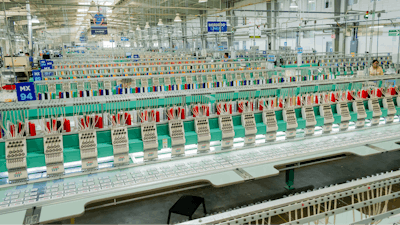
Based in South Florida, World Emblem says it is the largest embroidery company in the world. The company operates plants in the U.S., Canada and Mexico and serves notable clients, including New Era, Aramark, Cintas and Perry Ellis.
World Emblem has a fleet of more than 500 Tajima single-head embroidery machines throughout its state-of-the-art facilities in North America.
Randy Carr is the second-generation CEO of family-owned World Emblem. Carr has been CEO for more than 20 years and has overseen the implementation of new technologies and methodologies that have transformed the company. He began his career as an apprentice to his father, Jerold Carr, who started the company in 1993.
In this exclusive interview, Randy Carr discusses the business case for reshoring, the risk of sole sourcing and problems with labor costs, inflation and resources.
IEN: For the sake of clarity, how do you differentiate between nearshoring, onshoring and reshoring?
 Randy Carr is the second-generation CEO of family-owned World Emblem.
Randy Carr is the second-generation CEO of family-owned World Emblem.
IEN: Did you previously offshore manufacturing?
Carr: World Emblem originally manufactured products exclusively in the U.S. After the passage of NAFTA, we opened a new factory in Aguascalientes, Mexico. Since then, we have continued to expand our operations exponentially in both countries.
IEN: Reshoring has received much of the hype, but it seems like more companies are opting for nearshoring because of reduced costs. Is there still a business case for reshoring?
Carr: The business case for reshoring depends on the industry and the products being produced or distributed. We would prefer to have more of our operations in the U.S., but a number of factors including labor costs, inflation and access to resources have inhibited us from expanding our domestic manufacturing further.
IEN: We’ve seen companies increase oversight into the supply chain to mitigate risk, is World Emblem being more critical of its suppliers? Are your clients watching with a closer eye?
Carr: We place great emphasis on finding the right suppliers for our business. Most of our suppliers are within the U.S., Mexico or Canada, which makes it easier for our managers and executive team to visit them in person and have greater oversight into production along with improved quality control.
IEN: When it comes to the supply chain, what keeps you up at night?
Carr: We are currently unaware of any upcoming price hikes from our suppliers, but our reliance on sole sourcing in certain areas does expose us to risk. As a result, we continue to build on multi-sourcing as a safeguard.
 A photo of World Emblem employees.
A photo of World Emblem employees.






















